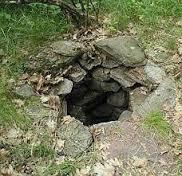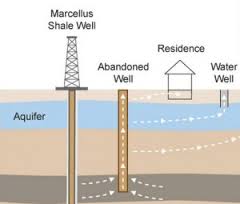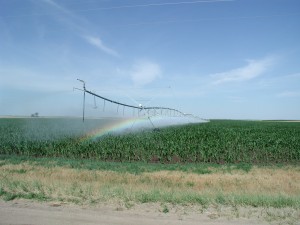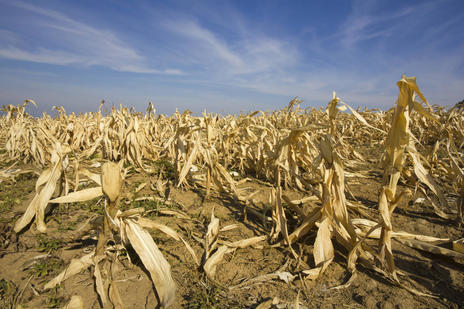Think before you drink
Are newly discovered chromium-6 levels in Boulder’s drinking water dangerous?
By Matt Cortina
Introductory Note: Chromium-6 comes and goes as a news item, but we appear to be no nearer a clear understanding of the real danger of the substance or a workable regulatory standard for water suppliers than when Erin Brochovich blew the whistle bringing it to public attention in the mid nineteen nineties. Matt Cortina’s article provides a really good overview of the dilemma.–Hardly Waite.
A potentially carcinogenic form of the element chromium is in Boulder’s drinking water and there are no plans to remove it anytime soon.
Hexavalent chromium, or chromium-6, has been linked to cancers of the liver, stomach, small intestine and more when it is consumed through water sources. It is unclear just how much chromium-6 must be consumed — and for how long — before any carcinogenic effects occur; research to date has been inconclusive and incomplete.
Because of the lack of data, there is no standard for chromium-6 levels in drinking water in Boulder, the state of Colorado and the rest of the country, besides California. What does exist is a standard for total chromium, (which includes chromium-6 and the benign trivalent chromium, chromium-3), a nascent wave of research and a lot of unanswered questions.
If hexavalent chromium sounds familiar, it’s likely for its co-starring role opposite Julia Roberts in the 2000 film Erin Brockovich. The true story on which the movie was based featured a legal clerk (Brockovich) who, from 1993 to 1996, built and won a classaction settlement against the utility company Pacific Gas & Electric (PG&E) that had contaminated the town of Hinkley, California’s water supply with chromium-6 between 1952 and 1966. The case was built on the correlation between the drinking water’s chromium-6 levels and an increase in tumor and cancer cases. The $333 million settlement was the largest settlement in U.S. history, and PG&E has since paid $315 million more in claims to victims.
The groundwater in Hinkley was found to have chromium-6 concentrations between .2 to 2.69 parts per billion (ppb), according to a PG&E survey, with higher contamination from the PG&E plant in pockets around town.
Chromium-6 levels in Boulder’s water currently range from .03 to .34 ppb, according to Boulder’s 2014 Water Quality Report. By comparison, the height of that range is more than five times higher than a .06 ppb public health goal set by California for chromium-6 in drinking water.
For some reason, Boulder’s chromi um-6 level is higher than nearby communities. Longmont sites registered from .035 and .061 ppb in 2013. Lafayette measured chromium-6 levels at .00026 ppb last year. Louisville reported “nondetect,” or zero, levels of the contaminant.
Out of 2,100 samples across Colorado taken since 2011, 78 percent were “non-detect” for total chromium, according to the Water Quality Control Division of the Colorado Department of Public Health and Environment (CDPHE). The CDPHE does not keep a database of chromium-6 levels, but said the highest recorded total chromium reading in its database in Boulder was 10 ppb.
Until this year, Boulder did not track chromium-6 levels and only tested previously for the contaminant’s presence in wastewater. Boulder now tracks for chromium-6 to comply with the EPA’s Unregulated Contaminant Monitoring Rule, which surveys communities around the country and collects data on certain contaminants.
In a 2010 Environmental Working Group study, 31 of 35 cities tested positive for chromium-6 in their drinking water. Norman, Okla. registered 12.9 ppb of chromium-6 in their water; a distant second was Honolulu at 2 ppb. Neither Boulder nor Denver were tested for the study, but Boulder’s .18 average would have tied it for 18th on the list with Chicago and Milwaukee.
Despite the widespread monitoring for chromium-6, there is no national chromium-6 standard and California’s public health goal (PHG) of .02 ppb and, later, .06 ppb on chromium-6 in drinking water supplies is the only state initiative.
Culminating that initiative, California will enact the nation’s first chromium-6 standard on July 1 at 10 ppb, nearly 500 times larger than the original PHG of .02 ppb. Environmental groups like EWG questioned the motives behind putting the standard at such a high level and said “24 million Californians would be exposed to potentially dangerous levels of hexavalent chromium” with the 10 ppb standard.
“Ideally you want nothing,” says Renée Sharp, Environmental Working Group director of research. “Chromium is known to be a carcinogen and creates a host of other health effects.”
Sharp says a realistic goal, given financial burdens and corporate realities, was 1 ppb of chromium-6 in the drinking water. Given that Boulder’s chromium-6 levels were above California’s initial PHGs, but below the 1 ppb recommendation, Sharp says, “I’m not going to be raising a crazy amount of alarm for those levels, but I also don’t want to say that they’re completely safe.”
Indeed, that’s the crux of the issue. With few standards in place, few carcinogenicity studies and zero comprehensive, long-term studies on chromium-6, it’s hard for lawmakers, communities and advocacy groups to know what danger, if any, chromium-6 levels in drinking water presents.
“There isn’t any direct drinking water quality standard [for chromium-6] we can compare it to right now,” says Michelle Wind, Boulder Drinking Water Program supervisor. “Our standards are set by the EPA and state public health department, so we’ll go by direction from them.”
That EPA standard is a 100 ppb limit on total chromium, which includes both chromium-3 and chromium-6.
The EPA combines them because chromium can change between chromium-3 and chromium-6 depending on its environment. Both chromium-3 and chromium-6 can be naturally occurring; chromium-3 is an essential nutrient found in soil and food, while chromium-6 found in water supplies is typically the byproduct of industrial processes that use it to rustproof and finish metal machinery, and also tan leather.
So because chromium-6 can become the benign chromium-3 in certain environments, and because one such environment is the human stomach, regulators treat both chromium states together when it comes to drinking water.
However, studies including a 2011 study by the California Office of Environmental Health Hazard Assessment (OEHHA), which ultimately determined the .02 PHG, have shown that although the majority of chromium-6 introduced to the human body by drinking water is likely reduced to chromium-3 in the digestive process, “it does not occur at a fast enough rate to prevent [chromium-6] from reaching and being taken up by tissues.” Furthermore, the study found that there were genotoxic — or DNA-damaging — effects in rodent organs that were given water containing chromium-6 levels “not likely to overwhelm the reductive capacities of the stomach, intestines and blood.” When DNA is damaged within cells, the cells can mutate and cause cancers.
The OEHHA study — in addition to others — even says gulping contaminated water too fast or having a full belly could determine how the human body processes ingested chromium-6.
Certain populations are likely more susceptible to chromium-6 toxicity than others. According to the EPA, “hexavalent forms can persist under conditions where there is a low concentration of reducing materials.” These forms include people with high pH levels in their stomachs, such as newborns and those who regularly take antacids. The 2011 OEHHA California study found that mice with a stomach pH of 4 or higher — typical of antacid users and newborns — showed a significant increase in tumors when given chromium-6 orally.
The EPA will meet in July to determine how it will “update its hazard identification and dose-response assessment of hexavalent chromium carcinogenicity by ingestion” in light of research done since a 1998 EPA study that couldn’t determine if ingested chromium-6 was carcinogenic.
One thing we know is that chromium-6 causes cancer when it’s inhaled. The EPA classifies chromium-6 as a “known human carcinogen by the inhalation route of exposure.” What’s not clear is if it’s carcinogenic when ingested, as in drinking water.
“I think it’s important to note that there’s no conclusive evidence right now of chromium-6 being a carcinogen,” said Nicole Graziano of the Water Quality Control Division of the CDPHE. “That’s one of the reasons why we evaluate total chromium in the drinking water, as opposed to one or the other of those chromium elements.”
The best resource available, then, to determine oral chromium-6 toxicity in humans is to look at past cases, like Hinkley, and studies recently finished or currently being done.
Zhang and Li (1987): A village in China reported increases in stomach cancer. Concurrently, there was a contamination of chromium-6 in the drinking water from a chromium ore processing facility. Initial reports finding no correlation were flawed and the case is now unsettled. Issues include that cancer rates were only tracked for 14 years, not all villagers were exposed to the contaminated water, and the initial report failed to note that although overall cancer rates were down, cancers in certain organs (in this case, the stomach) were elevated.
Nebraska (1986-87): Total chromium was measured against mortality rates for certain Nebraska counties. After tracking data for only two years, there was no correlation found between chromium-6 levels and cancer.
Leon Valley, Mexico (1995): Measurements of chromium in groundwater, soil and human urine were taken near a chromate composition facility; however, no cancer data was taken. Researchers did note that residents stopped drinking the water at 500 ppb of total chromium because it was yellow in color.
Hinkley, California (1996-2008): Water wells in Hinkley, California were contaminated with chromium-6 released by the Pacific Gas & Electric plant. According to the OEHHA, at least 46 people were exposed to chromium-6 via eight drinking water wells. Even though subsequent studies have found Hinkley had lower relative cancer rates than other communities at the time, the types of cancers were not recorded. Nearly a thousand people were ultimately affected.
Oinofito, Greece (2011): A chromium-6 concentration as high as 54 ppb was found in Oinofito. Cancer rates were monitored and a “statistically significant rate ratio for primary liver cancer mortality” was found, according to the OEHHA.
In sum, only two cases tracked organspecific cancers with relation to chromium-6: one found a link to liver cancer mortality and the other to stomach cancer mortality. The other cases lacked critical data to make meaningful determinations.
Researchers have also done lab tests — mainly with rodents — to try to determine chromium-6 human carcinogenicity via drinking water. In an April 2014 EPA toxicological review, researchers noted that previous studies couldn’t determine if oral ingestion of chromium-6 was carcinogenic but noted five studies since then — by the EPA and National Toxicology Program among others — that found small intestine tumors in rodents given chromium-6 orally.
But do chromium-6 experiments on rodents transfer to human physiology? Though there are small differences, “the human physiologically based pharmacokinetic model (i.e. essentially a diagram of human digestion and nutrient absorption) for chromium shares nearly the same structure as that developed for rats and mice,” according to a 2013 study published in the scientific journal Elsevier.
Chromium-6 has also been linked to other health effects. In fact, Graziano pointed out the EPA set its chromium-6 water limit at 100 ppb “assuming at the time that the most risk was due to dermatitis — as an allergic reaction to skin.”
Water highly concentrated with chromium-6 can even lead to problems from “inhalation of aerosol droplets generated during showering,” according to the OEHHA.
Ingestion of chromium-6 can lead to liver failure, oral ulcers, diarrhea, indigestion, vomiting, anemia, sperm count decrease and developmental issues, according the EPA’s 2014 toxicological review.
Chromium-6 combined with other contaminants may cause health risks for some people.
“Not only do we know that if you ingest chromium that you’ll have a higher risk of cancer, it’s not the only chemical you’re being exposed to,” says Sharp (of the EWG.) “One of the major problems with our drinking water standards are that they consider one single chemical alone when we know we are exposed to many, many chemicals, that combinations of chemicals do have additives, [that] these chemicals have a synergistic effect, and that some people are more sensitive to certain chemicals than others.”
Chemical combinations, studies on mice, case studies with missing data — it all leads to one question: at what level is chromium-6 in drinking water dangerous?
On Boulder’s water, Wind says, “I would classify it as at the current level and with the current standards in place it’s not a concern for us in terms of priority for changing treatment process.”
Cal Youngberg, environmental services manager for the public works department in Longmont, says, “We don’t have any information to say [that it’s not safe]. We don’t know what the effect of longterm exposure is. We don’t have any info on that. The work [to date] hasn’t been scientifically validated or peer-reviewed.”
Graziano, of the CDPHE, says, “For total chromium it’s at a safe level,” but could not comment on the safety of the chromium-6 levels.
That is, the lack of data and of clear case results limits the ability of local regulators to determine if current chromium-6 levels in drinking water are safe.
Another issue is that it’s not clear from where chromium contamination comes.
Graziano, of the CDPHE, says, “Because we regulate for total chromium, we aren’t analyzing for the source of where those particular chromium elements came from.”
“It’s hard to say where chromium comes from,” Longmont’s Youngberg says. “It looks like a lot of this is in the soil formation, or coming from the atmosphere in general.”
Wind suggests chromium-6 could be created during the treatment process.
“I would assume that [the chromium-6 in our water is naturally occurring],” Wind says. “It could be a combination of natural and [man-made]. We have seen some information that it could be something that forms in the treatment process. I can’t really say which portion it might be changing form in. It may be changing form to hexavalent chromium in the treatment process.”
Although chromium-3 can be converted to chromium-6 (through a process called oxidation), this conversion is typically only done to then remove chromium from the water if other methods of removal are not available.
Boulder gets its water from four water sources: Barker Reservoir, Lakewood Reservoir, Boulder Reservoir and Carter Lake. From there it is treated at one of two water treatment facilities: the Betasso Water Treatment Plant and the Boulder Reservoir Water Treatment Plant.
Neither Wind nor Youngberg says last September’s flood had any impact on the chromium-6 levels in the water.
The cost of removing chromium-6 — at whatever concentration — certainly impacts how decisions are made to remove it.
“I do know a major reason why the California level was not lower [than 10 ppb] is because chromium is not an inexpensive chemical to remove,” Sharp says.
“Because of that, unfortunately, it means that most water utilities are not going to remove something unless they are required to by law because it’s quite expensive.”
Much of the studies done to determine cost, including a 2014 Water Research Foundation study, found that capital costs for a new treatment plant in an area where the water is heavily saturated with chromium-6 (more than 20 ppb) could cost anywhere between $1 million and $10 million, depending on capacity, efficiency and demand.
Though large-scale operations to remove the contaminant may be expensive, there are options to inexpensively remove low levels of chromium-6 from the water supply in towns with sufficient water treatment facilities, according to a 2004 American Water Works Association study.
That study recommended two technologies for municipalities looking to remove low levels of chromium-6 from their water supply to adopt: anion exchange and reverse osmosis. Both, the study said, are “highly effective, mature technolog[ies]” that interested municipalities could feasibly implement.
In anion exchange, contaminated water is sent through a specialized metal vessel and passed through a resin that exchanges the chromium-6 ions for other, harmless ions in the resin.
In reverse osmosis treatment, water is forced through a membrane that separates the chromium from the water.
According to the American Water Works Association study, both methods are effective but large amounts of water are lost through reverse osmosis, rendering it less efficient.
Water Research Foundation Senior Research Manager Alice Fulmer says, however, that the low-level technologies researched are only proven to remove chromium-6 from water down to 1 ppb.
Given that Boulder’s chromium-6 levels fall below the 1 ppb threshold, Fulmer says, “I don’t see any of these technologies feasible or even necessary for Boulder’s water treatment facility yet.”
However, both reverse osmosis and anion exchange processes have the added benefit of shutting out other contaminants. Says Sharp:
“What’s really interesting is that they’re looking at how much it would cost to treat chromium down to a particular level and the benefits. But, if you install some sort of new treatment technology, you’re going to remove things other than [chromium-6], not everything, but you’re going to be cleaning up other chemicals and so there are other benefits. As far as I can tell, it’s a huge oversight.”
Boulder currently uses a coagulation and filtration method to treat water.
Wind says Boulder will defer action on chromium-6 levels until they get higher or a new standard is put in place.
“We don’t have a threshold right now [for too much chromium-6]. Our main go-by is the total chromium drinking water standard. Right now we’re a couple of orders of magnitudes below that. If we looked at California levels and we got in at something around that, we’d look into it a bit more, particularly if [the chromium-6 level] was increasing.”
Wind adds, “We haven’t even looked at what that [the cost of removing chromium-6 from drinking water] would be.”
Source: Boulder Weekly.
Previous Gazette articles on Hexavalent Chromium.









![rc400[1]](http://www.purewatergazette.net/blog/wp-content/uploads/2012/12/rc4001.jpg)



